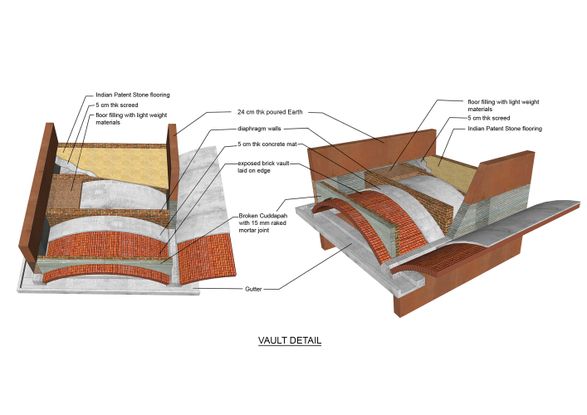Humanscapes Habitat Urban Living
ARCHITECTS
Auroville Design Consultant
CATEGORY
Urban Planning, Sustainability, Residential
LOCATION
Auroville, India
AREA
1753 m²
CLIENTS
Auroville Foundation
PHOTOGRAPHS
Akshay Arora, John Mandeen
LANDSCAPE
Auroville Design Consultants
MANUFACTURERS
Autodesk, Earth - Cement - Agreegate (C&D) Mix, Jsw Cement & Priya Cement, Local Traditional Technique In India, Locally Made, Mrf, Quarried And Sold Via Local Dealers (Non Branded), Tiscon/ Vizag, Trimble, Waste Collected From Stone Factories, Waste From Construciton Sites Around
YEAR
2018
CONSULTANTS
Auroville Earth Institute, Sunlit Future, Auroville Energy Services
DESIGN TEAM
Suhasini Ayer, Gavury Ramadas, Ramya Prasad, Abraham Ninan, Gnana Arul
STRUCTURAL ENGINEER
Dr. S. Kothandaraman
LEAD ARCHITECT
Suhasini Ayer
Text description provided by architect.
The “HUMANSCAPES HABITAT- is an applied research and demonstration project of Sustainable and Integrated Urban Living Project” for benchmarking in habitat as a course correction for a sustainable and harmonious model of development which is an imperative need in the present global crisis of energy and climate change.
This mixed-use development of residences, community, and workspace would be a touchstone for standards for low-embodied energy building.
This project also wants to address the issues of skill development upgrade the capability in the unorganized labor sector of India in the construction sector to transition construction jobs from building with high embodied energy materials to building materials and technology to reduce the carbon footprint in the habitat sector to meet India’s commitment to IPCC.
Using local building materials and skills, the residences become a net energy-positive habitat by generating their own energy, using renewable energy.
Zero-discharge of water, reduction, and recycling of solid waste, drought-resistant local endemic species landscaping, and growing organic food as a model for urban agriculture would be a hallmark of this project.
Reducing point-to-point travel by integrating work and living spaces, using integrated community and IT infrastructure (ICITI), and using clean mobility options like e- vehicles for external contact will be a natural consequence of the campus set-up.
The habitat project has integrated four goals as part of the sustainable human settlement program of development; • Sustainable built environment to have building envelopes that are solar passive to be climatically suitable built with efficient space usage to reduce the built-up area and low embodied energy building materials with construction techniques that require minimum processing and machinery.
• Integrated environmental planning of water, energy, and waste so Zero-discharge of water, reduction, and recycling of solid waste, water-efficient landscaping using local endemic species, and growing organic food as a model for urban agriculture would be a hallmark of these residences.
• The human ecology, using the principles of the “Cohousing” concept of living, facilitating interaction among neighbors for inclusive social development, economic and environmental benefits.
A functional fusion, the living, working, recreational and primary amenities allowing a multiplicity of space usage to reduce the built-up area to enable the inhabitants to interact actively with the farming and productive landscaping, waste recycling, and energy generation as part of the open learning campus.
• Establish a collaborative network of knowledge resources called ‘SustaiNet’, to facilitate further dissemination. This network will enable inter-institutional knowledge sharing and dissemination, a platform for academics, students, and professionals to have an inclusive learning experience during and after completion of the project.

























